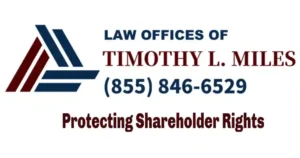Introduction to the Red Cat Class Action Lawsuit
The Red Cat class action lawsuit seeks to represent purchasers or acquirers of Red Cat Holdings, Inc. (NASDAQ: RCAT) securities between March 18, 2022 and January 15, 2025, inclusive (the “Class Period”). Captioned Olsen v. Red Cat Holdings, Inc., No. 25-cv-05427 (D.N.J.), the Red Cat class action lawsuit charges Red Cat and certain of Red Cat’s top current and former executives with violations of the Securities Exchange Act of 1934.
If you suffered substantial losses and wish to serve as lead plaintiff of the Red Cat class action lawsuit, or just have general questions about you rights as a shareholder, please contact attorney Timothy L. Miles of the Law Offices of Timothy L. Miles, at no cost, by calling 855/846-6529 or via e-mail at [email protected]. Lead plaintiff motions for the Red Cat class action lawsuit must be filed with the court no later than July 22, 2025.
In this comprehensive guide, we will analyze in detail how to overcome a motion to dismiss in a securities fraud class action like the Red Cat class action lawsuit.
Overview of the Allegations in the Red Cat Class Action Lawsuit
Red Cat, together with its subsidiaries, provides products and solutions to drone industry. Red Cat’s products include, among others, the “Teal 2” drone, a small, unmanned aircraft system designed to purportedly “Dominate the Night” during nighttime military operations.
The Red Cat class action lawsuit alleges that defendants throughout the Class Period made false and/or misleading statements and/or failed to disclose that: (i) Red Cat’s Salt Lake City facility’s production capacity, and defendants’ progress in developing the same, was overstated; and (ii) the overall value of Red Cat’s Short Range Reconnaissance Program of Record Tranche 2 contract (the “SRR Contract”) was overstated.
The Red Cat class action lawsuit further alleges that on July 27, 2023, Red Cat revealed that its Salt Lake City facility could only currently produce 100 drones per month, the facility was still being built, refined, and expanded, and that construction of the facility was only “substantially completed” and potentially could reach a production capacity of 1,000 drones per month over the next 2 to 3 years, but only with additional capital investments and manufacturing efficiencies realized. On this news, the price of Red Cat stock fell nearly 9%, according to the complaint.

Then, on September 23, 2024, the Red Cat class action lawsuit further alleges that Red Cat announced its financial results for the first quarter of fiscal year 2025, reporting losses per share of $0.17, missing consensus estimates by $0.09, and revenue of $2.8 million, missing consensus estimates by $1.07 million. According to the complaint, Red Cat further disclosed that Red Cat had spent “the past four months . . . retooling [the Salt Lake City facility] and preparing for high volume production,” while admitting that a “pause in manufacturing of Teal 2 and building Army prototypes impacted Teal 2 sales” because, among other things, Red Cat “couldn’t produce and sell Teal 2 units while retooling [its] factory.”
The Red Cat class action lawsuit alleges that on this news, the price of Red Cat stock fell more than 25%.
Finally, the Red Cat class action lawsuit further alleges that on January 16, 2025, Kerrisdale Capital published a report alleging that “[t]he SRR contract that Red Cat won in November and preemptively announced without the Army’s permission is much smaller and less favorable than management as intimated,” and that “[i]t’s highly implausible that a mass-production facility for manufacturing drones has been built at any point in the last two years for less than $1 million.” On this news, the price of Red Cat stock fell more than 21% over two trading sessions, according to the Red Cat lawsuit.
Red Cat Faces Class Action Over Alleged Securities Fraud
A class action lawsuit against Red Cat Holdings has been filed in the United States District Court for the District of New Jersey as “Olsen v. Red Cat Holdings, Inc.” (No. 25-cv-05427). The drone technology company and several of its top executives face charges of violating the Securities Exchange Act of 1934. These charges specifically target alleged false statements and material omissions during the class period.
The Red Cat class action lawsuit aims to represent investors who bought Red Cat securities between March 18, 2022, and January 15, 2025.
The Red Cat lawsuit focuses on two major misrepresentations. The plaintiffs claim Red Cat made false claims about its Salt Lake City facility’s production capacity and misled investors about its manufacturing progress. They also assert that the company inflated the value of its Short Range Reconnaissance Program of Record Tranche 2 contract (the “SRR Contract”) with the U.S. Army.

The company’s alleged misrepresentations led to serious financial losses through multiple stock price drops. The stock fell nearly 9% after Red Cat revealed on July 27, 2023, that its Salt Lake City facility could only produce 100 drones monthly – nowhere near the implied capabilities. The stock took another hit, dropping more than 25% over two trading sessions after disappointing Q1 fiscal year 2025 results came out on September 23, 2024.
The biggest blow came after Kerrisdale Capital released a report on January 16, 2025. The report revealed the SRR Contract was worth only $20-25 million based on U.S. Army budget documents – this is a big deal as it means that management’s suggestions were incorrect. Red Cat’s stock price fell $2.35 per share, or 21.54% over two trading sessions as a result.
The court has set July 22, 2025, as the deadline for investors to request appointment as lead plaintiff in the case.
Lawsuit Alleges False Statements and Material Omissions
The lawsuit against Red Cat centers on claims of false and misleading statements made during the Class Period. Legal documents show that executives thought over misrepresenting two key aspects of company operations.
Red Cat’s claims about its Salt Lake City facility’s production capabilities came under scrutiny. The company boasted about its ability to produce “thousands of drones per month” or “tens of thousands of drones per year” throughout 2022. Management confirmed in March 2023 that “The Salt Lake City factory is complete and ready to go” and “We now have the capacity to produce thousands of drones per month”. Plaintiffs claim the reality was starkly different – the facility could only produce 100 drones monthly.
The Red Cat lawsuit also targets Red Cat’s SRR Contract value inflation. The company described the agreement’s worth as “hundreds of millions to over a billion dollars” and showed confidence in generating $50-79.5 million in revenue from this contract in fiscal year 2025. Kerrisdale Capital’s analysis of U.S. Army budget documents revealed the contract’s actual value was just $20-25 million. The plaintiffs also point out that Red Cat “announced the win without Army approval”, which could affect future negotiations.
The Red Cat lawsuit highlights suspicious insider activities. George Matus, the company’s former CTO who created the SRR-winning drone design, stepped down and sold most of his stock right after securing the Army contract. CEO John Thompson also sold his shares during this time.
The company’s financial statements showed no major capital spending toward building the promised mass production infrastructure, which contradicted their public statements. The defendants’ positive claims about Red Cat’s business operations and future prospects were “materially misleading and/or lacked a reasonable basis at all relevant times”, supporting the securities fraud claims.
Common Grounds for a Motion to Dismiss
When faced with a securities fraud class action lawsuit such as the Red Cat class action lawsuit, defendants often file a motion to dismiss as an initial defensive strategy. This motion aims to convince the court that the plaintiffs’ complaint is legally insufficient and should not proceed to trial. There are several common grounds on which defendants base their motions to dismiss, each of which presents unique challenges for the plaintiffs to overcome.
One common ground for dismissal is the failure to state a claim upon which relief can be granted. Under this argument, the defendants assert that, even if all the allegations in the complaint are true, they do not constitute a violation of securities laws.
This ground requires the plaintiffs to demonstrate that their allegations, if proven, would indeed establish a legal basis for their claims. This involves a nuanced understanding of securities laws and the ability to articulate how the defendants’ actions meet the criteria for fraud.

Another frequent ground for dismissal is the lack of specificity and particularity in the plaintiffs’ allegations. Securities fraud claims are subject to heightened pleading standards under the Private Securities Litigation Reform Act (PSLRA).
This means that plaintiffs in the Red Cat class action lawsuit must provide detailed and specific facts to support their allegations of fraud, rather than relying on broad or vague statements.
Defendants often argue that the plaintiffs’ complaint fails to meet these stringent requirements, necessitating a dismissal.
Additionally, defendants may contend that the plaintiffs have not adequately demonstrated loss causation in the Red Cat class action lawsuit. Loss causation refers to the causal connection between the defendants’ fraudulent conduct and the plaintiffs’ financial losses. In other words, the plaintiffs must show that their losses were directly caused by the defendants’ actions, rather than by other market factors.
Defendants may argue that the plaintiffs have not sufficiently established this link, thereby undermining the basis for their claims.
Legal Standards for Surviving a Motion to Dismiss
To survive a motion to dismiss, plaintiffs in the Red Cat class action lawsuit must navigate a series of strict legal standards. These standards are designed to ensure that only meritorious cases proceed to the discovery phase and, potentially, to trial. Understanding these standards is crucial for plaintiffs as they craft their response to a motion to dismiss.
One of the primary legal standards is the requirement to state a claim upon which relief can be granted. This standard, derived from Federal Rule of Civil Procedure 12(b)(6), requires plaintiffs to present a plausible claim for relief. The court must accept all well-pleaded allegations in the complaint as true and draw all reasonable inferences in favor of the plaintiffs.
However, the allegations must go beyond mere speculation and must present a coherent and plausible narrative that, if proven, would constitute securities fraud.
Key Strategies to Defeat a Motion to Dismiss
Defeating a motion to dismiss requires a well-thought-out strategy that addresses the specific grounds on which the motion is based. Plaintiffs in the Red Cat class action lawsuit, must carefully craft their arguments and provide detailed evidence to counter the defendants’ assertions. Several key strategies can enhance the likelihood of overcoming a motion to dismiss in a securities fraud class action lawsuit such as the Red Cat lawsuit.
First, plaintiffs should focus on the specificity and particularity of their allegations in the Red Cat class action lawsuit. Given the heightened pleading standards under the PSLRA, it is essential to present detailed and specific facts that support the claims of fraud.
This includes identifying each allegedly misleading statement, explaining why it is misleading, and providing factual evidence to support the inference of scienter.
By meticulously detailing the fraudulent conduct, plaintiffs can demonstrate that their claims are well-founded and meet the legal requirements.
Second, plaintiffs should emphasize the causal connection between the defendants’ actions and their financial losses. Establishing loss causation is a critical component of surviving a motion to dismiss and will be a challenge in the Red Cat class action lawsuit, Plaintiffs should provide a clear and compelling narrative that links the fraudulent conduct alleged in the Red Cat class action lawsuit to the economic harm suffered.
This may involve presenting market analysis, expert testimony, and other evidence that demonstrates how the defendants’ actions directly impacted the plaintiffs’ investments.
Third, plaintiffs can leverage recent legal precedents to strengthen their arguments. Courts often rely on past rulings to guide their decisions, so citing relevant case law can bolster the plaintiffs’ position. By identifying and referencing cases with similar facts and legal issues where motions to dismiss were denied, plaintiffs can persuade the court that the Red Cat lawsuit should proceed to discovery
This strategy requires thorough legal research and a deep understanding of the evolving legal landscape in securities fraud litigation.
Importance of Pleading Specificity and Particularity
In securities fraud class action lawsuits, the importance of pleading specificity and particularity cannot be overstated. The heightened pleading standards under the PSLRA require plaintiffs to provide detailed and precise allegations to support their claims. This stringent requirement is designed to filter out baseless lawsuits and ensure that only meritorious cases move forward.
To meet these standards, plaintiffs in the Red Cat class action lawsuit must meticulously detail each allegedly misleading statement made by the defendants. This includes specifying the exact content of the statement, the context in which it was made, and the reasons why it is considered misleading. General or vague allegations are insufficient; the complaint must provide a clear and specific account of the fraudulent conduct.

This level of detail helps the court assess the validity of the claims and determine whether the case should proceed.
In addition to pinpointing the misleading statements, plaintiffs must also provide factual evidence to support the inference of scienter. Scienter refers to the defendants’ intent or knowledge of wrongdoing.
Plaintiffs in the Red Cat class action lawsuit must present facts that demonstrate the defendants acted with fraudulent intent or were recklessly indifferent to the truth.
This can include evidence of insider trading, suspicious timing of transactions, or other indicators of fraudulent intent. The specificity and particularity in pleading scienter are crucial for establishing the credibility of the plaintiffs’ claims in the Organon class action lawsuit.
Furthermore, particularity in pleading helps plaintiffs establish loss causation. By providing detailed allegations that link the defendants’ fraudulent conduct to the plaintiffs’ financial losses, the complaint can demonstrate a clear causal connection. This involves presenting specific facts that show how the defendants’ actions directly impacted the value of the plaintiffs’ investments.
The more precise and detailed the allegations, the stronger the case for establishing loss causation and surviving a motion to dismiss in the Red Cat lawsuit.
Role of Evidence in Overcoming a Motion to Dismiss
Evidence plays a pivotal role in overcoming a motion to dismiss in a securities fraud class action lawsuit. While the motion to dismiss stage does not involve the full presentation of evidence as in a trial, plaintiffs in the Red Cat class action lawsuit must still provide sufficient factual support for their allegations to convince the court that their claims are plausible. This requires a strategic approach to gathering and presenting evidence even at the early stages of litigation.
One key aspect of evidence in this context is the use of documentary evidence to support the allegations. This can include company financial statements, press releases, regulatory filings, and other documents that contain the allegedly misleading statements. Plaintiffs should meticulously review these documents to identify inconsistencies, inaccuracies, or omissions that support their claims of fraud.
By providing concrete evidence from the defendants’ own communications, plaintiffs can strengthen their case and demonstrate the credibility of their allegations in the Organon class action lawsuit.
In addition to documentary evidence, plaintiffs can also rely on expert testimony to bolster their claims. Experts in fields such as finance, accounting, and securities law can provide valuable insights and analysis that support the plaintiffs’ allegations.
For example, a financial expert might analyze market trends and demonstrate how the defendants’ misleading statements artificially inflated the company’s stock price, leading to the plaintiffs’ losses.
Expert testimony can add depth and credibility to the plaintiffs’ case, helping to persuade the court that the claims are well-founded.
Moreover, plaintiffs can use circumstantial evidence to support their allegations of scienter. This can include evidence of suspicious trading activity, such as insider trading by company executives, or unusual patterns in the timing of disclosures. Circumstantial evidence can help establish the defendants’ intent or knowledge of wrongdoing, which is a critical component of securities fraud claims.
By presenting a compelling narrative that connects the dots between the evidence and the allegations, plaintiffs can effectively counter the defendants’ motion to dismiss. There is little doubt all of these points will be at issue in the Red Cat class action lawsuit.
The Impact of Recent Legal Precedents
Recent legal precedents play a crucial role in shaping the landscape of securities fraud class action lawsuits and influencing the strategies employed by plaintiffs and defendants alike. Courts often look to prior rulings to guide their decisions, making it essential for plaintiffs to stay abreast of the latest developments in securities law.
One significant precedent is the Supreme Court’s decision in Tellabs Inc. v. Makor Issues & Rights, Ltd. In this case, the Court clarified the standard for pleading scienter in securities fraud cases. The ruling emphasized that plaintiffs must provide a “cogent and compelling” inference of scienter, which is at least as compelling as any opposing inference of non-fraudulent intent.

This heightened standard has made it more challenging for plaintiffs to survive motions to dismiss, in a case such as the Red Cat class action lawsuit, underscoring the importance of detailed and specific allegations. Plaintiffs must meticulously craft their complaints to meet this stringent requirement and demonstrate a strong inference of fraudulent intent.
Another important precedent is the Supreme Court’s decision in Halliburton Co. v. Erica P. John Fund, Inc. This ruling established that plaintiffs can rely on the “fraud-on-the-market” theory to demonstrate reliance in securities fraud cases. Under this theory, plaintiffs can presume that they relied on the integrity of the market price, which was distorted by the defendants’ fraudulent conduct.
This precedent has significant implications for class certification and the ability of plaintiffs to proceed as a class. By leveraging this theory, plaintiffs in the Red Cat class action lawsuit. can strengthen their arguments and increase their chances of surviving a motion to dismiss.
The Ninth Circuit’s decision in In re NVIDIA Corp. Securities Litigation also offers valuable insights. The court in this case emphasized the importance of providing detailed and particular allegations to meet the PSLRA’s heightened pleading standards.
The ruling highlighted that plaintiffs must specify each misleading statement, the reasons why it is misleading, and the facts supporting an inference of scienter.
This precedent reinforces the need for plaintiffs to thoroughly document their claims and provide a comprehensive narrative that supports their allegations of fraud. By adhering to these legal standards, plaintiffs in the Red Cat class action lawsuit. can enhance their prospects of overcoming a motion to dismiss.
Conclusion and Next Steps for Plaintiffs
Surviving a motion to dismiss in a securities fraud class action lawsuit is a critical milestone that can determine the trajectory of the litigation. Plaintiffs in the Red Cat class action lawsuit, must navigate a complex web of legal standards, procedural requirements, and strategic considerations to effectively counter the defendants’ efforts to have the case thrown out.
By understanding the common grounds for dismissal, the importance of pleading specificity and particularity, and the role of evidence, plaintiffs can craft a persuasive response that meets the stringent requirements of the law and allows the Red Cat lawsuit to proceed to the discovery state.
As the Red Cat lawsuit demonstrates, meticulous attention to detail and a well-thought-out strategy are essential for overcoming a motion to dismiss. Plaintiffs must provide detailed and specific allegations that support their claims of fraud, establish a clear causal connection between the defendants’ actions and their financial losses, and leverage recent legal precedents to bolster their arguments.
By doing so, they can enhance their chances of surviving the motion to dismiss and moving forward with the discovery process.
For plaintiffs, the next steps involve thoroughly reviewing and strengthening their complaint, gathering and presenting compelling evidence, and preparing for the discovery phase. This may include working with legal experts, financial analysts, and other professionals to build a robust case that can withstand the defendants’ challenges.
By staying informed about the latest developments in securities law and learning from successful defenses in similar cases, plaintiffs can position themselves for success in their pursuit of justice.
In conclusion, defeating a motion to dismiss in a securities fraud class action lawsuit like the Red Cat lawsuit, requires a combination of legal acumen, strategic planning, and meticulous attention to detail. Plaintiffs must be prepared to meet the heightened pleading standards, provide compelling evidence, and craft a persuasive narrative that demonstrates the validity of their claims.
By doing so, they can navigate the complexities of securities fraud litigation and seek accountability for the alleged misconduct.
Contact Timothy L. Miles Today About a Red Cat Class Action Lawsuit
If you suffered losses in Red Cat stock, call us today for a free case evaluation about a Red Cat Class Action Lawsuit. 855-846-6529 or [email protected] (24/7/365).
Timothy L. Miles, Esq.
Law Offices of Timothy L. Miles
Tapestry at Brentwood Town Center
300 Centerview Dr. #247
Mailbox #1091
Brentwood,TN 37027
Phone: (855) Tim-MLaw (855-846-6529)
Email: [email protected]
Website: www.classactionlawyertn.com
Facebook Linkedin Pinterest youtube



